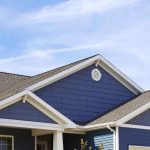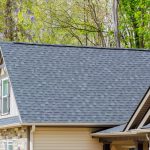Your roof has an incredibly important job. It protects you, your family, and your belongings from everything nature has to throw at it. When it’s working well, you more than likely don’t give it a second thought. If something goes wrong and it leaks, this can be incredibly frustrating to deal with.
Storm Damage
While there are many reasons that a roof might develop a leak, one of the most common is that damage that is done during a storm. Even if you can’t see the damage, that doesn’t mean it’s not there. Below are some of the ways that a storm can impact your roof.
Water Damage
Every so often, there will be a giant storm that rolls through that brings with it torrential rains. The water from these storms can find their way through cracks or holes that have developed in your roof and seep into your home. This can cause a lot of damage, including leading to the growth of mold and mildew.
In addition, water can get under shingles or the flashings on your roof and cause rot to happen. When this takes hold, the structural integrity of your roof is compromised. This can lead to more water seeping into your home or even the possibility of partial or entire roof collapse.
Wind Damage
Wind can cause a lot of damage to your roof in a variety of ways. If you have any loose shingles, it can grab a hold of these and tear them off your home. If the wind doesn’t tear them completely off, it can lift them from the surface. In both cases, the chances for water to get into your home increases.
Strong winds can also blow dirt and other debris across the surface of your roof, and this can create small holes or scratches in the surface, which then lessens their ability to do their job. This dirt and leaves can also get caught in your gutters and clog them. If the water can’t flow freely through the downspouts, then it may find a way into your home.
A strong enough gale can also blow tree branches or an entire tree onto your roof. This can cause major damage to your structure. The best way to reduce the chances of this happening includes keeping trees trimmed so that they aren’t overhanging your roof and planting trees far enough away from your home. On average, you want 6 feet of clearance between your home and tree branches.
Hail Damage
Most people have seen the damage that hail can cause. Even small pea-sized balls of ice can dent cars, shred vegetation, and leave marks on the sides of houses. You may not be able to see the damage, but hail does a number on your roof. It can create tiny holes or damage shingles, allowing water to get into your home.
Dealing with Storm Damage
The best way to deal with storm damage is to get your roof inspected. Remember, just because you may not see visible damage, that doesn’t mean it’s not there. Calling in a professional is the best course of action to take, as they will know exactly what to look for and be able to give you information on how to correct the problem.
If there is visible damage, such as a tree falling on your home or shingles being ripped off, getting a professional out as soon as possible is recommended. They’ll be able to put up some temporary measures such as tarping to protect your home until the roof can be repaired.
Dealing with roof damage from a storm can be a stressful experience. Getting a roof repaired or replaced isn’t always the cheapest endeavor to undertake. However, it’s an important one. Without this item on your home, all of your belongings would be ruined and your house may even collapse. Storms can wreak a lot of havoc, but the damage they cause can be mitigated.
If you have storm damage to your roof that needs to be looked at, get in touch with the professionals at George Kent. We’ll be able to let you know what needs to be done to get your roof back in proper working order so you can rest easy.





